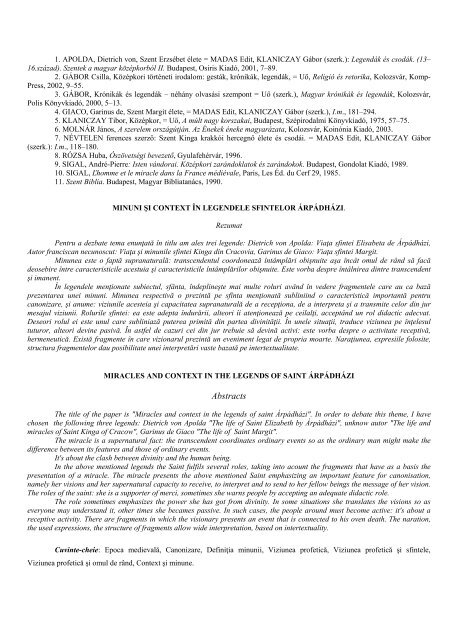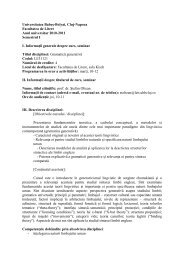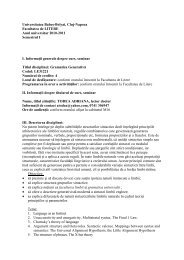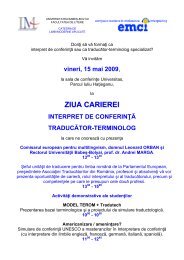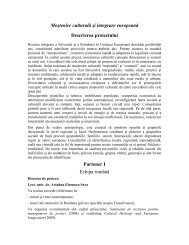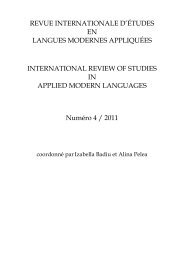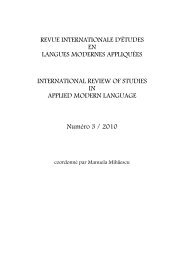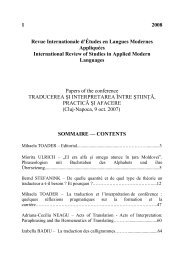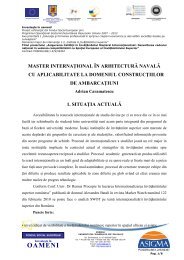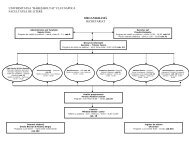Dimensiuni ale limbajului n context carceral
Dimensiuni ale limbajului n context carceral
Dimensiuni ale limbajului n context carceral
Create successful ePaper yourself
Turn your PDF publications into a flip-book with our unique Google optimized e-Paper software.
1. APOLDA, Dietrich von, Szent Erzsébet élete = MADAS Edit, KLANICZAY Gábor (szerk.): Legendák és csodák. (13–<br />
16.század). Szentek a magyar középkorból II. Budapest, Osiris Kiadó, 2001, 7–89.<br />
2. GÁBOR Csilla, Középkori történeti irodalom: gesták, krónikák, legendák, = Uő, Religió és retorika, Kolozsvár, Komp-<br />
Press, 2002, 9–55.<br />
3. GÁBOR, Krónikák és legendák – néhány olvasási szempont = Uő (szerk.), Magyar krónikák és legendák, Kolozsvár,<br />
Polis Könyvkiadó, 2000, 5–13.<br />
4. GIACO, Garinus de, Szent Margit élete, = MADAS Edit, KLANICZAY Gábor (szerk.), I.m., 181–294.<br />
5. KLANICZAY Tibor, Középkor, = Uő, A múlt nagy korszakai, Budapest, Szépirodalmi Könyvkiadó, 1975, 57–75.<br />
6. MOLNÁR János, A szerelem országútján. Az Énekek éneke magyarázata, Kolozsvár, Koinónia Kiadó, 2003.<br />
7. NÉVTELEN ferences szerző: Szent Kinga krakkói hercegnő élete és csodái. = MADAS Edit, KLANICZAY Gábor<br />
(szerk.): I.m., 118–180.<br />
8. RÓZSA Huba, Ószövetségi bevezető, Gyulafehérvár, 1996.<br />
9. SIGAL, André-Pierre: Isten vándorai. Középkori zarándoklatok és zarándokok. Budapest, Gondolat Kiadó, 1989.<br />
10. SIGAL, Ľhomme et le miracle dans la France médiév<strong>ale</strong>, Paris, Les Éd. du Cerf 29, 1985.<br />
11. Szent Biblia. Budapest, Magyar Bibliatanács, 1990.<br />
MINUNI ŞI CONTEXT ÎN LEGENDELE SFINTELOR ÁRPÁDHÁZI.<br />
Rezumat<br />
Pentru a dezbate tema enunţată în titlu am <strong>ale</strong>s trei legende: Dietrich von Apolda: Viaţa sfintei Elisabeta de Árpádházi,<br />
Autor franciscan necunoscut: Viaţa şi minunile sfintei Kinga din Cracovia, Garinus de Giaco: Viaţa sfintei Margit.<br />
Minunea este o faptă supranaturală: transcendentul coordonează întâmplări obişnuite aşa încât omul de rând să facă<br />
deosebire între caracteristicile acestuia şi caracteristicile întâmplărilor obişnuite. Este vorba despre întâlnirea dintre transcendent<br />
şi imanent.<br />
În legendele menţionate subiectul, sfânta, îndeplineşte mai multe roluri având în vedere fragmentele care au ca bază<br />
prezentarea unei minuni. Minunea respectivă o prezintă pe sfînta menţionată subliniind o caracteristică importantă pentru<br />
canonizare, şi anume: viziunile acesteia şi capacitatea supranaturală de a recepţiona, de a interpreta şi a transmite celor din jur<br />
mesajul viziunii. Rolurile sfintei: ea este adepta îndurării, alteori îi atenţionează pe ceilalţi, acceptând un rol didactic adecvat.<br />
Deseori rolul ei este unul care subliniază puterea primită din partea divinităţii. În unele situaţii, traduce viziunea pe înţelesul<br />
tuturor, alteori devine pasivă. În astfel de cazuri cei din jur trebuie să devină activi: este vorba despre o activitate receptivă,<br />
hermeneutică. Există fragmente în care vizionarul prezintă un eveniment legat de propria moarte. Naraţiunea, expresiile folosite,<br />
structura fragmentelor dau posibilitate unei interpretări vaste bazată pe intertextualitate.<br />
MIRACLES AND CONTEXT IN THE LEGENDS OF SAINT ÁRPÁDHÁZI<br />
Abstracts<br />
The title of the paper is "Miracles and <strong>context</strong> in the legends of saint Árpádházi". In order to debate this theme, I have<br />
chosen the following three legends: Dietrich von Apolda "The life of Saint Elizabeth by Árpádházi", unknow autor "The life and<br />
miracles of Saint Kinga of Cracow", Garinus de Giaco "The life of Saint Margit".<br />
The miracle is a supernatural fact: the transcendent coordinates ordinary events so as the ordinary man might make the<br />
difference between its features and those of ordinary events.<br />
It's about the clash between divinity and the human being.<br />
In the above mentioned legends the Saint fulfils several roles, taking into acount the fragments that have as a basis the<br />
presentation of a miracle. The miracle presents the above mentioned Saint emphasizing an important feature for canonisation,<br />
namely her visions and her supernatural capacity to receive, to interpret and to send to her fellow beings the message of her vision.<br />
The roles of the saint: she is a supporter of merci, sometimes she warns people by accepting an adequate didactic role.<br />
The role sometimes emphasizes the power she has got from divinity. In some situations she translates the visions so as<br />
everyone may understand it, other times she becames passive. In such cases, the people around must become active: it's about a<br />
receptive activity. There are fragments in which the visionary presents an event that is connected to his oven death. The naration,<br />
the used expressions, the structure of fragments allow wide interpretation, based on intertextuality.<br />
Cuvinte-cheie: Epoca medievală, Canonizare, Definiţia minunii, Viziunea profetică, Viziunea profetică şi sfintele,<br />
Viziunea profetică şi omul de rând, Context şi minune.


